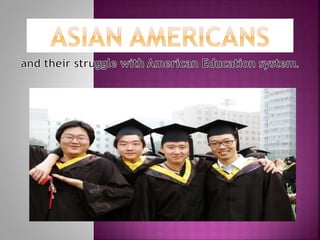Recommended
More Related Content
What's hot
What's hot (20)
Industrial america part 2 immigration urbanization and labor 2016

Industrial america part 2 immigration urbanization and labor 2016
Lecture 11 part i- american expansion west - mexican territories & west

Lecture 11 part i- american expansion west - mexican territories & west
Viewers also liked
Nafsa region-xi-mental-health-chinese-students-2016Exploring Mental Health Awareness and Obstacles Among Chinese International S...

Exploring Mental Health Awareness and Obstacles Among Chinese International S...International Student Insurance
Viewers also liked (20)
Searching for His Chinese American Identity: A Psychologist Morphed into A H...

Searching for His Chinese American Identity: A Psychologist Morphed into A H...
College Admissions by Asian Advantage College Consulting

College Admissions by Asian Advantage College Consulting
Health promotion: Asian american health disparities

Health promotion: Asian american health disparities
Exploring Mental Health Awareness and Obstacles Among Chinese International S...

Exploring Mental Health Awareness and Obstacles Among Chinese International S...
MCCA 2011: Following the Suffering Servant as an Asian American

MCCA 2011: Following the Suffering Servant as an Asian American
Asian American Values, Cross-Cultural Communication and the Work Place

Asian American Values, Cross-Cultural Communication and the Work Place
Similar to Asian americans
Similar to Asian americans (20)
Chapter EightUnderstanding the AsianAmerican & LatinoEx.docx

Chapter EightUnderstanding the AsianAmerican & LatinoEx.docx
Lisa Graustein's "The Historical Roots of Inequity and Resistance in Public E...

Lisa Graustein's "The Historical Roots of Inequity and Resistance in Public E...
The Urban Review, VoL 39, No. 4, November 2007 (© 2007)DOI.docx

The Urban Review, VoL 39, No. 4, November 2007 (© 2007)DOI.docx
Analytical Essay Essay 1 - and justice for allDue timedate .docx

Analytical Essay Essay 1 - and justice for allDue timedate .docx
98 Ibid., 227.99 Prior to the Supreme Court decision, California.docx

98 Ibid., 227.99 Prior to the Supreme Court decision, California.docx
WEEK 6· Chapter 13 • Goodbye America The Chicano in t.docx

WEEK 6· Chapter 13 • Goodbye America The Chicano in t.docx
Lecture NotesImmigration and the United States Chapter 4 Imm.docx

Lecture NotesImmigration and the United States Chapter 4 Imm.docx
Asian americans
- 2. Chinese immigrants began to appear in California in the 1850’s to join the gold rush. By 1852, there were approximately 20,000 Chinese immigrants in California. By the 1960’s approximately 16,000 Chinese immigrants were working in the California gold fields. As mining profits decreased, immigrants began working for the transcontinental railroad at wages 1/3 less than white laborers.
- 3. By Japanese law in 1639, they were not permitted to travel to other countries until 1868. In 1869, Hawaiian planters recruited 148 Japanese contract laborers and 100 were permitted to work in the silk industry in California. By 1920, as many as 389,999 Japanese, 8,000 Koreans, and 6,400 Asian Indians immigrated to Hawaii and the United States mainland. By 1930, 150,000 Filipinos were recruited as laborers after the U.S. captured the Philippine Islands in 1907.
- 4. 1790: Naturalization Act: Only “free whites” eligible for naturalized citizenship (Categorized all Asians as “Mongolian”) 1855: US Supreme Court rules Chinese are not white therefore, they are ineligible for citizenship 1872: California school code provides no education for Asians 1882: Chinese Exclusion Law bans all Chinese workers from the U.S. 1885: California creates segregated schools for Chinese and Tape vs. Harvey case provides Asian Americans access to schools 1906: San Francisco creates segregated schools for Chinese, Japanese, and Koreans 1920’s: Laws in many states denied the rights to own property to any non-citizen and in 1924, Mississippi segregates Chinese students from white students 1941-1945 Internment of Japanese Americans in concentration camps 1943: Congress rescinds Chinese Exclusion Act and grants Chinese rights for citizenship 1952 McCarran-Walter Act rescinds restrictions from the 1790 Naturalization Act 1965: Immigration Act ends discrimination against Asians 1974: Lau v. Nichols requires schools to provide help for ESL students
- 5. Coolie Deviant Yellow Peril Model Minority Gook
- 6. A threat to the “white working family” and their living standard.
- 7. A threat to the morality the white family
- 8. A threat that Asian Immigrants are overrunning the United States
- 9. A faceless enemy that began around WWII.
- 10. This stereotype was used to criticize the African Americans and Hispanics during the civil rights era. However, in later years, this stereotype has been detrimental to many Asian students who “struggle” academically.
- 11. 50% of Asians, age 25 and older, who have a bachelor's degree or higher level of education. Asians have the highest proportion of college graduates of any race or ethnic group in the country and this compares with 28 percent for all Americans 25 and older. 85.1% percentage of Asians, age 25 and older, who are high school graduates. 20.7% percentage of Asians, age 25 and older, who have an advanced degree (e.g., Master's, Ph.D., M.D. or J.D.). This compares with 10 percent for all Americans 25 and older. However, different Asian ethnic groups have different educational attainment levels -- 68 percent of Asian Indians, age 25 and older, had a bachelor's degree or more education and 37 percent had a graduate or professional degree; the corresponding numbers for Vietnamese-Americans were 24 percent and 7 percent, respectively. 80% Percentage of Asian Americans living in a household with Internet use.
- 12. The U.S. Commission on Civil Rights names the model minority as the most destructive stereotype for Asian Americans. Not all Asian Americans excel academically Their academic achievement can hide psychological problems They attain achievement through willingness to work and not genetics Asian Americans sacrifice other skills and knowledge for academic success
- 13. In modern years, Asian Americans have excelled in American society. However, it is important as educators to realize all children are different and learn differently. True success comes from hard work!

